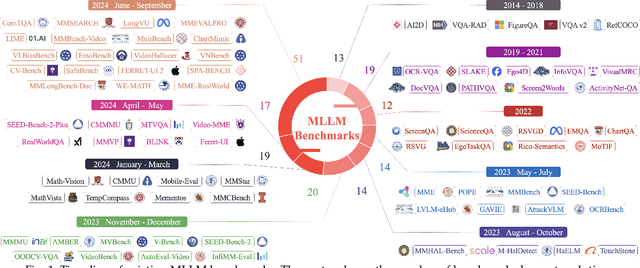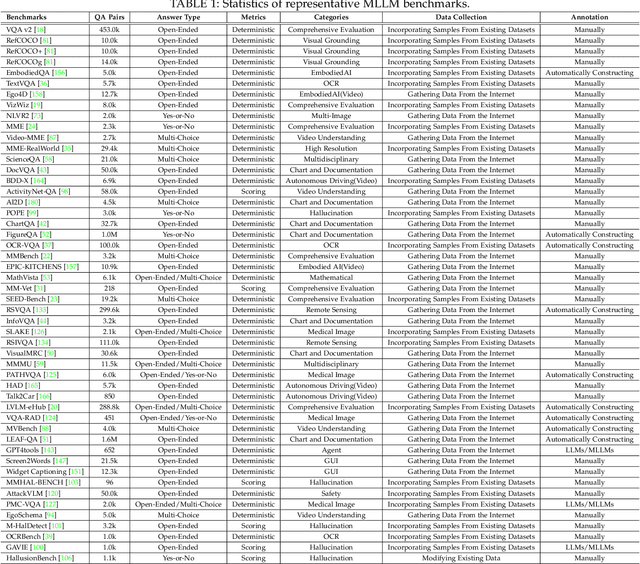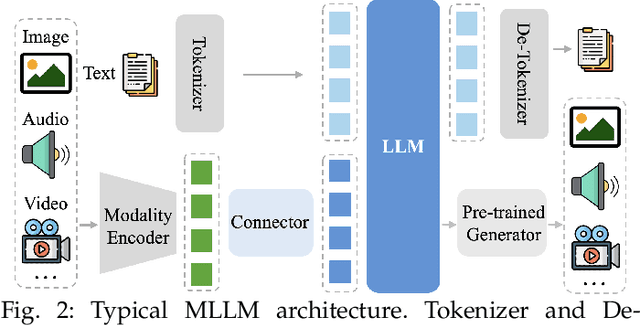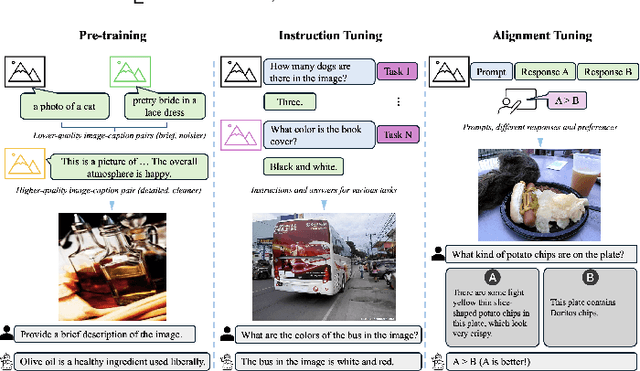Xinyu Fang
Creation-MMBench: Assessing Context-Aware Creative Intelligence in MLLM
Mar 19, 2025Abstract:Creativity is a fundamental aspect of intelligence, involving the ability to generate novel and appropriate solutions across diverse contexts. While Large Language Models (LLMs) have been extensively evaluated for their creative capabilities, the assessment of Multimodal Large Language Models (MLLMs) in this domain remains largely unexplored. To address this gap, we introduce Creation-MMBench, a multimodal benchmark specifically designed to evaluate the creative capabilities of MLLMs in real-world, image-based tasks. The benchmark comprises 765 test cases spanning 51 fine-grained tasks. To ensure rigorous evaluation, we define instance-specific evaluation criteria for each test case, guiding the assessment of both general response quality and factual consistency with visual inputs. Experimental results reveal that current open-source MLLMs significantly underperform compared to proprietary models in creative tasks. Furthermore, our analysis demonstrates that visual fine-tuning can negatively impact the base LLM's creative abilities. Creation-MMBench provides valuable insights for advancing MLLM creativity and establishes a foundation for future improvements in multimodal generative intelligence. Full data and evaluation code is released on https://github.com/open-compass/Creation-MMBench.
OmniAlign-V: Towards Enhanced Alignment of MLLMs with Human Preference
Feb 25, 2025Abstract:Recent advancements in open-source multi-modal large language models (MLLMs) have primarily focused on enhancing foundational capabilities, leaving a significant gap in human preference alignment. This paper introduces OmniAlign-V, a comprehensive dataset of 200K high-quality training samples featuring diverse images, complex questions, and varied response formats to improve MLLMs' alignment with human preferences. We also present MM-AlignBench, a human-annotated benchmark specifically designed to evaluate MLLMs' alignment with human values. Experimental results show that finetuning MLLMs with OmniAlign-V, using Supervised Fine-Tuning (SFT) or Direct Preference Optimization (DPO), significantly enhances human preference alignment while maintaining or enhancing performance on standard VQA benchmarks, preserving their fundamental capabilities. Our datasets, benchmark, code and checkpoints have been released at https://github.com/PhoenixZ810/OmniAlign-V.
MME-Survey: A Comprehensive Survey on Evaluation of Multimodal LLMs
Nov 22, 2024



Abstract:As a prominent direction of Artificial General Intelligence (AGI), Multimodal Large Language Models (MLLMs) have garnered increased attention from both industry and academia. Building upon pre-trained LLMs, this family of models further develops multimodal perception and reasoning capabilities that are impressive, such as writing code given a flow chart or creating stories based on an image. In the development process, evaluation is critical since it provides intuitive feedback and guidance on improving models. Distinct from the traditional train-eval-test paradigm that only favors a single task like image classification, the versatility of MLLMs has spurred the rise of various new benchmarks and evaluation methods. In this paper, we aim to present a comprehensive survey of MLLM evaluation, discussing four key aspects: 1) the summarised benchmarks types divided by the evaluation capabilities, including foundation capabilities, model self-analysis, and extented applications; 2) the typical process of benchmark counstruction, consisting of data collection, annotation, and precautions; 3) the systematic evaluation manner composed of judge, metric, and toolkit; 4) the outlook for the next benchmark. This work aims to offer researchers an easy grasp of how to effectively evaluate MLLMs according to different needs and to inspire better evaluation methods, thereby driving the progress of MLLM research.
V-LoRA: An Efficient and Flexible System Boosts Vision Applications with LoRA LMM
Nov 01, 2024



Abstract:Large Multimodal Models (LMMs) have shown significant progress in various complex vision tasks with the solid linguistic and reasoning capacity inherited from large language models (LMMs). Low-rank adaptation (LoRA) offers a promising method to integrate external knowledge into LMMs, compensating for their limitations on domain-specific tasks. However, the existing LoRA model serving is excessively computationally expensive and causes extremely high latency. In this paper, we present an end-to-end solution that empowers diverse vision tasks and enriches vision applications with LoRA LMMs. Our system, VaLoRA, enables accurate and efficient vision tasks by 1) an accuracy-aware LoRA adapter generation approach that generates LoRA adapters rich in domain-specific knowledge to meet application-specific accuracy requirements, 2) an adaptive-tiling LoRA adapters batching operator that efficiently computes concurrent heterogeneous LoRA adapters, and 3) a flexible LoRA adapter orchestration mechanism that manages application requests and LoRA adapters to achieve the lowest average response latency. We prototype VaLoRA on five popular vision tasks on three LMMs. Experiment results reveal that VaLoRA improves 24-62% of the accuracy compared to the original LMMs and reduces 20-89% of the latency compared to the state-of-the-art LoRA model serving systems.
ProSA: Assessing and Understanding the Prompt Sensitivity of LLMs
Oct 16, 2024



Abstract:Large language models (LLMs) have demonstrated impressive capabilities across various tasks, but their performance is highly sensitive to the prompts utilized. This variability poses challenges for accurate assessment and user satisfaction. Current research frequently overlooks instance-level prompt variations and their implications on subjective evaluations. To address these shortcomings, we introduce ProSA, a framework designed to evaluate and comprehend prompt sensitivity in LLMs. ProSA incorporates a novel sensitivity metric, PromptSensiScore, and leverages decoding confidence to elucidate underlying mechanisms. Our extensive study, spanning multiple tasks, uncovers that prompt sensitivity fluctuates across datasets and models, with larger models exhibiting enhanced robustness. We observe that few-shot examples can alleviate this sensitivity issue, and subjective evaluations are also susceptible to prompt sensitivities, particularly in complex, reasoning-oriented tasks. Furthermore, our findings indicate that higher model confidence correlates with increased prompt robustness. We believe this work will serve as a helpful tool in studying prompt sensitivity of LLMs. The project is released at: https://github.com/open-compass/ProSA .
MuMA-ToM: Multi-modal Multi-Agent Theory of Mind
Aug 22, 2024Abstract:Understanding people's social interactions in complex real-world scenarios often relies on intricate mental reasoning. To truly understand how and why people interact with one another, we must infer the underlying mental states that give rise to the social interactions, i.e., Theory of Mind reasoning in multi-agent interactions. Additionally, social interactions are often multi-modal -- we can watch people's actions, hear their conversations, and/or read about their past behaviors. For AI systems to successfully and safely interact with people in real-world environments, they also need to understand people's mental states as well as their inferences about each other's mental states based on multi-modal information about their interactions. For this, we introduce MuMA-ToM, a Multi-modal Multi-Agent Theory of Mind benchmark. MuMA-ToM is the first multi-modal Theory of Mind benchmark that evaluates mental reasoning in embodied multi-agent interactions. In MuMA-ToM, we provide video and text descriptions of people's multi-modal behavior in realistic household environments. Based on the context, we then ask questions about people's goals, beliefs, and beliefs about others' goals. We validated MuMA-ToM in a human experiment and provided a human baseline. We also proposed a novel multi-modal, multi-agent ToM model, LIMP (Language model-based Inverse Multi-agent Planning). Our experimental results show that LIMP significantly outperforms state-of-the-art methods, including large multi-modal models (e.g., GPT-4o, Gemini-1.5 Pro) and a recent multi-modal ToM model, BIP-ALM.
JieHua Paintings Style Feature Extracting Model using Stable Diffusion with ControlNet
Aug 21, 2024


Abstract:This study proposes a novel approach to extract stylistic features of Jiehua: the utilization of the Fine-tuned Stable Diffusion Model with ControlNet (FSDMC) to refine depiction techniques from artists' Jiehua. The training data for FSDMC is based on the opensource Jiehua artist's work collected from the Internet, which were subsequently manually constructed in the format of (Original Image, Canny Edge Features, Text Prompt). By employing the optimal hyperparameters identified in this paper, it was observed FSDMC outperforms CycleGAN, another mainstream style transfer model. FSDMC achieves FID of 3.27 on the dataset and also surpasses CycleGAN in terms of expert evaluation. This not only demonstrates the model's high effectiveness in extracting Jiehua's style features, but also preserves the original pre-trained semantic information. The findings of this study suggest that the application of FSDMC with appropriate hyperparameters can enhance the efficacy of the Stable Diffusion Model in the field of traditional art style migration tasks, particularly within the context of Jiehua.
A New Chinese Landscape Paintings Generation Model based on Stable Diffusion using DreamBooth
Aug 16, 2024Abstract:This study mainly introduces a method combining the Stable Diffusion Model (SDM) and Parameter-Efficient Fine-Tuning method for generating Chinese Landscape Paintings. This training process is accelerated by combining LoRA with pre-trained SDM and DreamBooth with pre-trained SDM, respectively. On the Chinese Landscape Paintings Internet dataset used in this paper, this study finds that SDM combined with DreamBooth exhibits superior performance, outperforming other models, including the generic pre-trained SDM and LoRA-based fine-tuning SDM. The SDM combined with DreamBooth achieves a FID of 12.75 on the dataset and outperforms all other models in terms of expert evaluation, highlighting the model's versatility in the field of Chinese Landscape Paintings given the unique identifier, high fidelity and high quality. This study illustrates the potential of specialised fine-tuning method to improve the performance of SDM on domain-specific tasks, particularly in the domain of Landscape Paintings.
VLMEvalKit: An Open-Source Toolkit for Evaluating Large Multi-Modality Models
Jul 16, 2024



Abstract:We present VLMEvalKit: an open-source toolkit for evaluating large multi-modality models based on PyTorch. The toolkit aims to provide a user-friendly and comprehensive framework for researchers and developers to evaluate existing multi-modality models and publish reproducible evaluation results. In VLMEvalKit, we implement over 70 different large multi-modality models, including both proprietary APIs and open-source models, as well as more than 20 different multi-modal benchmarks. By implementing a single interface, new models can be easily added to the toolkit, while the toolkit automatically handles the remaining workloads, including data preparation, distributed inference, prediction post-processing, and metric calculation. Although the toolkit is currently mainly used for evaluating large vision-language models, its design is compatible with future updates that incorporate additional modalities, such as audio and video. Based on the evaluation results obtained with the toolkit, we host OpenVLM Leaderboard, a comprehensive leaderboard to track the progress of multi-modality learning research. The toolkit is released at https://github.com/open-compass/VLMEvalKit and is actively maintained.
Prism: A Framework for Decoupling and Assessing the Capabilities of VLMs
Jun 20, 2024Abstract:Vision Language Models (VLMs) demonstrate remarkable proficiency in addressing a wide array of visual questions, which requires strong perception and reasoning faculties. Assessing these two competencies independently is crucial for model refinement, despite the inherent difficulty due to the intertwined nature of seeing and reasoning in existing VLMs. To tackle this issue, we present Prism, an innovative framework designed to disentangle the perception and reasoning processes involved in visual question solving. Prism comprises two distinct stages: a perception stage that utilizes a VLM to extract and articulate visual information in textual form, and a reasoning stage that formulates responses based on the extracted visual information using a Large Language Model (LLM). This modular design enables the systematic comparison and assessment of both proprietary and open-source VLM for their perception and reasoning strengths. Our analytical framework provides several valuable insights, underscoring Prism's potential as a cost-effective solution for vision-language tasks. By combining a streamlined VLM focused on perception with a powerful LLM tailored for reasoning, Prism achieves superior results in general vision-language tasks while substantially cutting down on training and operational expenses. Quantitative evaluations show that Prism, when configured with a vanilla 2B LLaVA and freely accessible GPT-3.5, delivers performance on par with VLMs $10 \times$ larger on the rigorous multimodal benchmark MMStar. The project is released at: https://github.com/SparksJoe/Prism.
 Add to Chrome
Add to Chrome Add to Firefox
Add to Firefox Add to Edge
Add to Edge